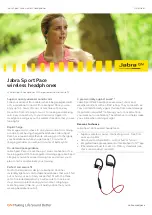S 9 9 2 2 M S E R I E S R O U T E R L T E S E R I E S U S E R M A N U E L
14
3.2
Wi-Fi SETTING
For a wireless connection, your router and computer, smartphone or tablet will need to
have the same Wi-Fi network name and security settings. Ricon recommends that you use
wireless security.
The default Wi-Fi network name and password appear on the Figure 4. Follow the steps
below to make Wi-Fi connection.
✓
SSID;
Set SSID is your Wi-Fi connection name.
✓
Network mode;
n, g, b.
-N:
Specifications providing for up to 300 Mbps of network bandwidth. N also offers
somewhat better range over earlier Wi-Fi standards due to its increased signal
intensity, and it is backward-compatible with B/G gear.
-G:
Support bandwidth up to 54 Mbps, and it uses the 2.4GHz frequency for greater
range.
-B:
Supports bandwidth up to 11 Mbps and Uses radio signal frequency 2.4GHz.
✓
Channel;
There are 11 different channel selection options.
✓
Bandwidth;
20mhz or 40mhz can be selected according to the specifications of the
devices you want to use in wireless network.
✓
AP Isolate;
Users connecting to your network can not access each other.
✓
Broadcast Status;
If you want the SSID to be hidden, select disable.
✓
Security Mode and Algorithms;
Disable, WPA, WPA2, TKIP, AES.
-Disable; Wireless network is connected to the network without password.
-WPA improved security, but is now also considered vulnerable to intrusion. WPA2,
while not perfect, is currently the most secure choice. Temporal Key Integrity
Protocol (TKIP) and Advanced Encryption Standard (AES) are the two different
types of encryption you’ll see used on networks secured with WPA2.
✓
WPA Shared Key;
Set is your Wi-Fi connection password.
✓
WPA Renewal Interval;
The number of seconds the wireless network needs to be
refreshed is entered here.
✓
Single click
Save
icon to finish.


















